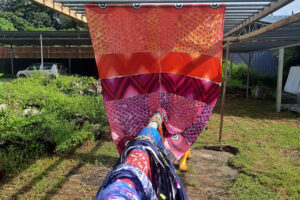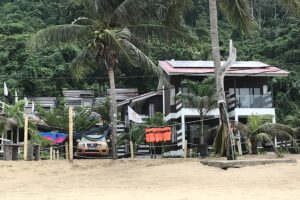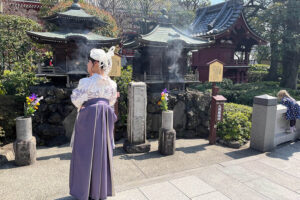
Trying – and Failing – hiking on Japan’s Shikoku Island
By Robin Kish

I’m not a novice hiker. I’ve trekked mountains and a couple of volcanoes, exposed to the full force of the equatorial sun.
And yet there I was on a mountain in Shikoku, Japan well under 1,000 meters, stammering, out of breath, a little ball of anxiety and sweat.
I was on a trail ascending from the Buddhist temple Iwaya-ji, #45 of the 88 temples on the O-Shikoku, a pilgrimage route in southwestern Japan.
The jagged trail was lined with stone shrines and bodhisattva statues; pilgrims, called Henro, had left offerings and so I knew humans had trod this path before.
However, with the height of the incline and July’s unforgiving humidity, I was the only one foolish enough to try the hike.
Shikoku Pilgrim Hiking Routes
I was on my first trip to Japan, a country rich with mountain trails and pilgrim routes. July is the humid, rainy season, but my travel was limited to the window of July and August and I desperately wanted a good hike.
Mount Fuji should have been the obvious route, since its season opens officially on July 1. But I also wanted to get out of the greater Tokyo area. I wanted to travel further into Japan’s belly. I wanted to be adventurous.
Shikoku offered such an adventure. Shikoku is a large island wedged between the Inland Sea and Pacific, connected to mainland Honshu by a series of causeways. It’s fairly remote as far as tourism goes and known for its natural beauty.
And it’s synonymous with Japan’s oldest pilgrimage, the O-Shikoku, or Shikoku 88, named for the number of temples dotting the island.
I didn’t have the time it would take to hike the entire 700+ mile route, but I did have a few days – enough time to work up some good blisters.
It was precisely the kind of attitude that would leave me stranded and anxious on top of a mountain.
Arrival: Tokyo to Hiroshima to Matsuyama

Since this was my first trip to Japan, I erred on the side of caution and settled on basing myself in Matsuyama, Shikoku island’s largest city.
Eight of the trail’s temples are in Matsuyama, with others in close proximity. I could stay in a guesthouse, spend a few days on the trail, and not have to worry about where I would sleep.
Getting to Matsuyama involved a four-hour train ride from Tokyo to Hiroshima, followed by an hour’s fast ferry across the Inland Sea.
From Matsuyama port, I caught a regular charter bus up to the Dogo Onsen bathhouse at the edge of the downtown center.
I was a bit giddy from all that travel, and when I stepped off the bus I found myself deposited in a romantic version of Japan I hadn’t expected.
Attached to the bathhouse (onsen) was an old-time arcade, nostalgic tram, an old-fashioned clock, more Harry Potter than Japanese lore.
Next to the arcade was a statue of famed haiku master and Matsuyama local Masaoka Shiki, bronzed out in a baseball uniform (in addition to poetry, he excelled in baseball, too).
And then, just up a steep hill, the spectacularly ornate Isaniwa Jinja, a Shinto shrine constructed in the 16th century.
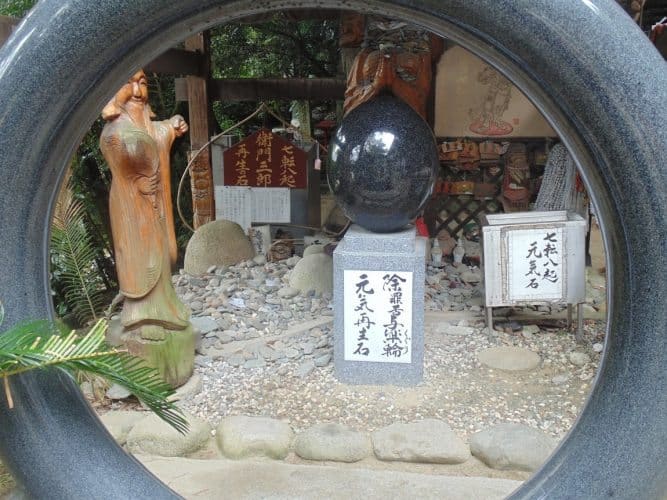
Three-part House Numbers
I’d booked a room at the Sen Guesthouse, which according to my map was near the bathhouse. My guidebook listed the address, but addresses are meaningless to anyone not familiar with the Japanese system.
The three-part numeric consists of a street number, building number, and floor number.
The streets are numbered according to their placement within a neighborhood, which means you have to know the neighborhood to know what street carries which number. For most visitors, addresses are impossible to navigate by.
I had to rely on locals for help. Most of the people I encountered spoke some English, but not much. Fortunately, the guidebook listed the Sen Guesthouse in Japanese characters and with the help of three extraordinarily friendly employees at a hotel, I managed to locate it.
Since language is an issue for most Western tourists in Japan, the Sen Guesthouse is the ideal place for a Western tourist to stay.
It’s run by Matt and Nori, a husband/wife team who are fluent in both Japanese and English – not a surprise since Matt’s an American. This is indeed a rarity in rural Japan!
He and Nori were immensely helpful, lifesavers when it came to navigating this western edge of Shikoku.
Hitting the O-Shikoku
My first day on the trail instilled in me a false sense of confidence. The day began with rain, and so Matt and Nori suggested a city-bound route that wouldn’t leave me stranded in the event of a downpour. I caught a tram to the city bus terminal, and then a local bus to the Southern neighborhoods of Matsuyama.

The O-Shikoku was founded by the Buddhist philosopher Kobo Daishi, known in life as Kukai, the father of Japanese Shingon Buddhism.
Although most famous for founding the monastic community at Koya-san, Kobo Daishi was born on Shikoku and returned many times throughout his life (774-835); here, he established small monastic communities, or converted existing ones to the Shingon school.
His followers kept up the work, creating what is today the O-Shikoku.
I’d be trekking the relatively short but doable route connecting Jodo-ji (#49) and Hanta-ji (#50) in the southern neighborhoods to Ishite-ji (#51) in central Matsuyama.
I’d armed myself with Shikoku Japan 88 Route Guide, the definitive English-language guide.
Few English speakers on the Trail

The book provides detailed maps, topographic information, bus routes, as well as information on temple etiquette, dress, and history.
It also includes Japanese characters in addition to English script; a necessity, since few people on the trail spoke English.
Fortunately, the trail I took through Matsuyama was fairly straightforward. The main route was marked with white signposts at regular intervals, emblazoned with red characters and a stick-figure hiker.

Since streets don’t have names, it was necessary to match the visuals on the map with what I could actually see – easier to do on the main route than on the secondary trails that were more scenic.
Jodo-ji and Hanta-ji were close together, embedded into the hillside of a city park.
Although both were near busy roads, each temple complex felt remote. Both were founded in the 8th century and were converted to the Shingon school by Kobo Daishi.
Both provided a good schematic for the layout of a Shikoku temple. The pilgrim, or Henro, must pass first through the outer gate, which keeps out evil spirits.
Then, she purifies herself by rinsing her hands and mouth in a basin of water. She announces her arrival by ringing a bell in front of the hondo, or main hall, where she recites sutras.
She recites these again at the Daishi-do, another hall that houses an image of Kobo Daishi. When she is finished, she can obtain a stamp from the temple office as proof of her visit.
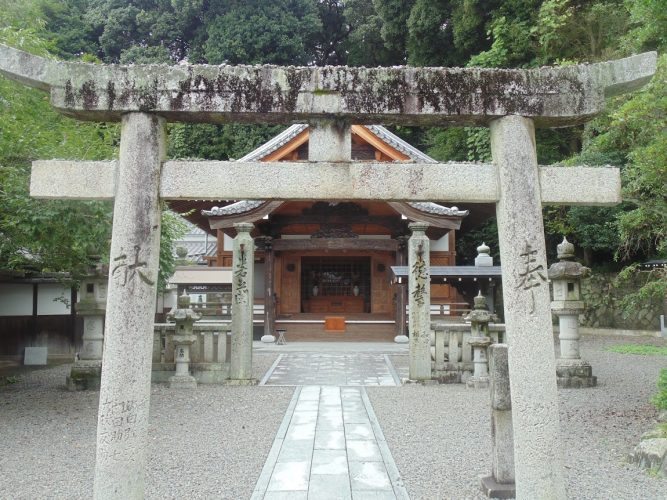
“A Religious Journey”
On this last part, the Shikoku Route Guide offers interesting advice: “It is important to remember this is a religious journey, not a stamp rally or backpacking trail.”
Ishite-ji (#51) was the most impressive of Matsuyama’s temples. Its three-story pagoda dates to the 14 th century (as opposed to Jodo-ji, which was rebuilt after destruction in the same century).
It was also the largest and most ornate. On display were masterful woodblock prints, colorful paper cranes, and intricate wooden shrines. The most unusual feature: a cave system which housed statues of Nyorai (Buddhas) and bodhisattvas.
I celebrated my successful completion of this first trek by heading back to the main gate at Ishite-ji, where a merchant was selling iced coffee and tea. At least I thought he was.
When I went to pay he waved me off with a smile. The beverages were free to all who enter. It was my first, but not last, glimpse at Shikoku hospitality.
Learning How and When to Take the Bus in Shikoku
The next day, I left Matsuyama behind and headed into the Shikoku wilderness. I caught an early JR Iyotetsu bus from Matsuyama station bound for the town of Kuma, from where I could catch the trail to Iwaya-ji (#45). The plan was to hike the 6 or so miles (about 9 kilometers)) from Iwaya-ji to Daiho-ji (#44).

Once outside Matsuyama, the Shikoku landscape became much like what I imagined Kobo Daishi would have recognized. Steep, green mountains rose dramatically out of the valleys, the type of romantic image painted on a screen.
The winding roadside was dotted with ancient shrines and villages that were little more than wooden houses huddled in the mountain shadows.
Only Two Left
By the time the bus reached Kuma, I was one of only two riders left. The other was a Henro. Walking is still considered the best method for pilgrimage since it requires the most mental, physical, and spiritual stamina, but it’s not practical for most modern Henro.
This woman was dressed in the traditional pilgrim’s garb: a conical hat, white linen vest and pant (the hakui), and a walking staff that housed the spirit of Kobo Daishi, a constant companion of any Henro.

Once off the bus, I followed the Henro across the narrow road and up a hill from the car park leading to the marked temple path.
Other worshipers were trickling out of their cars, which should have been my first sign of things to come: few people were actually on foot for the journey.
But I was excited to be out on a real trail that wasn’t in a city, and I was determined not to rely on four wheels any more than I had to.
Carved into the Pass
Unlike the temples within Matsuyama, Iwaya-ji was carved into a mountain pass. According to my guidebook, the temple was a “nansho” or “difficult place”. I could see why as soon as I hit the trail.
The path switchbacked into the mountain, passing mossy pagodas and clusters of stone Jizo, the guardian deity of children and travelers. Many had been garbed in red knit hats and bibs, common offerings for the Jizo as the protector of children’s souls.
Unlike the city temples, the climb to Iwaya-ji was an aesthetic experience. At the top, everyone was winded. But the climb was well worth the effort. The path was hauntingly beautiful and the wooden temple structures blended harmoniously into the mountain.
According to legend, Kobo Daishi was presented this location by a mysterious recluse who lived in the woods; it was easy to believe such stories when I heard the soft chants of the pilgrims or the call of the arrival’s bell echoing off the rock.
The climb was worth the effort for another reason, too. The shared experience created a sense of camaraderie I’d hardly noticed the day before. People would greet each other warmly with breathless hellos. They’d stick out their tongues and fan themselves playfully in the heat.
I knew then I wasn’t going to make it all the way to Daiho-ji on foot. The day was just too hot. I did climb about another twenty minutes, stopping for breath at the end of every switchback. The mountain was slick with mud and ankle-breaking pebbles, and at some point in the switchbacks, the Shikoku signposts suddenly stopped. If I continued, there would be far more uncertainty – more adventure – than I was looking for.
Not Just a Hiking Trip!
I needed to remember the guidebook’s warning: this wasn’t simply a hiking trip. For me, it was about recognizing what I couldn’t do alone in a new land.
Back at the bus stop, I saw a cluster of Henro waiting, including the woman I’d ridden in with. She’d succumbed to the heat, too. Yes, she assured me when I showed her the Japanese character on my map, this was the bus to Daiho-ji. When we arrived there, the bus driver dropped us at an unmarked stop and the woman let me know this was where I had to get off.
She was kind enough to let me follow her up the next trail, which I wouldn’t have found without her.

Robin Kish is a freelance writer who has visited thirty countries and territories over the past two decades. Her work has appeared in The Smart Set, Hayden’s Ferry Review, Cutthroat, and other literary and online journals. She teaches writing at the University of Massachusetts Dartmouth.
- Mongolia, the Land of Eternal Blue Sky - April 20, 2024
- These 9 U.S. National Parks Require Reservations in 2024 - April 17, 2024
- Take a Hike in Olympic National Park - April 17, 2024



